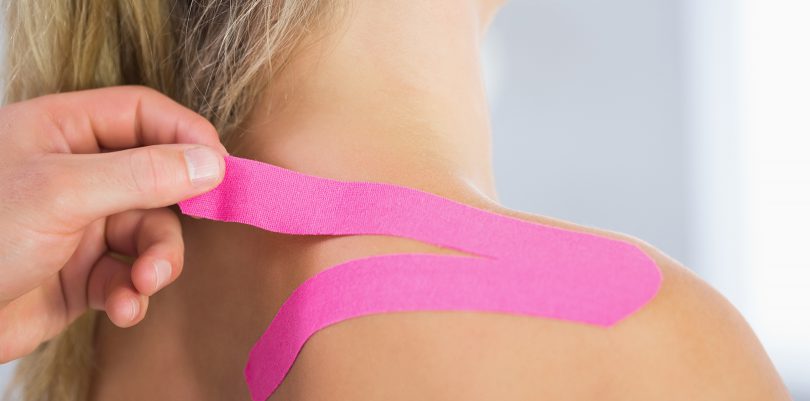Migraines, back problems, overload – Every now and then everyone has pain in various parts of the body and hardly anything helps. But: You can simply stick the pain away! With Kinesio Tapes this is no longer a problem today. In sports injuries and various other ailments and pains originally come from the Japanese medicine strips promise alleviation. You can buy them in online shops, pharmacies, at physiotherapists or at sporting goods shops. Our guide will tell you all the important information about Kinesio tape to relieve pain and how it can help you.
Kinesio tape to relieve pain: What does “taping” mean?
The flexible adhesive strips are also known under the Kinesio tape, the abbreviation of the kinesiological tape. But also physio tape, muscle tape or medical or therapeutic tape are similar terms. What is a kinesio tape? It is a highly elastic, breathable and skin-friendly cotton tape with an acrylic adhesive layer, similar to a long cotton plaster. The tape can adapt to the natural movements of the body because it is just as elastic and thick as our skin. The application of the self-adhesive Kinesio tape to relieve pain is referred to as “taping”.
With every movement, the skin is displaced against the underlying tissue, stimulating blood circulation and lymph flow. The irritation of nerve endings in the upper layers of the skin can alleviate pain and positively influence muscle activity, so you can apply the Kinesio tape to relieve pain.
What is the tape used for?
Although there is no scientific evidence for the effectiveness of the tape, it is often used in general for movement restrictions or pain, strains, overloads or inflammation, since, according to experience reports, nevertheless, a positive effect. Among other things with these injuries and complaints the elastic adhesive tape is often used:
- Muscle injuries, tension and discomfort
- Joint injuries and complaints (ankle and knee joint or elbow)
- ligament injuries
- sports injuries
- back pain
- Bad posture and poor posture
- neck pain
- shoulder pain
- tendon disorders
- migraine
- Water retention (lymphedema)
- arthrosis
- scoliosis
Especially with sports injuries, the therapeutic tape can be very helpful, because it contributes to the protection by its supportive effect. So it is used as a standard therapy method in sports medicine, but also in physiotherapy and orthopedics.
Kinesio tape to relieve pain: uses
Tapes are used for various ailments as well as injuries. Its stabilizing effect is intended to activate and support the self-healing process of the body. Inflamed or injured muscles, ligaments or joints can be stabilized and relieved while remaining flexible. This may shorten the healing process and relieve pain. In addition, muscles can be loosened, inflammation inhibited and the blood and lymph circulation at the respective body site can be stimulated.
How does taping work?
The affected areas of the skin should be shaved or shaved before applying the colorful strips, as direct skin contact makes it look and feel much better. The skin should be fat-free, clean and dry. So wash and dry them first, but do not cream them! The tape is first cut to the correct length, the corners rounded and warmly rubbed with the help of both hands, so that it sticks better and longer to the skin. Afterwards, the film is peeled off and the Kinesio Tape is fixed on the skin. After attaching the tape, it makes sense to rub over it several times with the flat hand to fix it even better. Do not cream after that.
Depending on discomfort, body location and method, the tape can be cut to different shapes. For example, if you cut it lengthwise in the middle, you will get a Y-shape that will make your knee joint wonderful. To achieve a higher stability, you can simply stick the tapes on and around each other, so that there is a supportive function from all sides.
It sticks to the skin for five to seven days and is usually waterproof and permeable to air, so water or sweat is no problem. If necessary, however, you can dry it down to a low level if it has become wet through swimming or showering. If you want to remove it after at least one week, then it should be replaced as carefully as possible in hair growth direction. Little tip: If you have problems or pain, you can use baby oil or olive oil or roll the tape off the skin. If symptoms continue to persist or pain after the first tape, then a new one is stuck to the skin again.
Can I tape myself?
Surely you’re wondering if you can just put on the elastic tape tapes yourself as this would be the most practical option. Depending on the medical history and symptoms, the affected area of the body must be placed in a specific position. Therefore, it would be advisable to have the tape created by a doctor, because he has the necessary expertise. However, if you are well instructed by your doctor and practice a lot, you may be able to tap yourself. In addition, if you have any questions, you can also turn to physiotherapists, occupational therapists and non-medical practitioners.
How tight or loose should the Kinesio tape be?
Make sure that there are no wrinkles in the tape or on the skin, and that the tape is not too tight and not too loose, as it should not restrict the movements and still stabilize them. However, so-called “convolutions” (visible waves in the tape) are not a problem, they even have a positive effect. The tape should be stuck in stretched position to create the waves. If you have pain in your joints or muscles, relax as you put on the elastic band. Tense muscles or irritated nerves on the other hand stretch. Also, the tape should always be stretched slightly before sticking. For swelling, however, glued without train. Sensitive areas, such as the face, tolerate only a little tension, strong areas like the thigh a little more.
What else should be considered when fixing the tape to avoid risks?
- After the tape has been applied, it is important to regularly check the body area for pain, throbbing, tingling sensation, numbness and freedom of movement and to pay attention to whether the skin is noticeably cold, pale or blue discolored. Maybe the colorful strip was stuck with too much tension.
- You have a plaster allergy? Then you should tell this to your doctor so that a special tape can be used.
- If you take certain medications such as cortisone: better avoid taping or consult with your doctor.
- For itching or redness of the skin after fixation: Get down with the medical tape! Possibly. here is an allergy.
- If you have open wounds, sunburn, skin infections or skin diseases such as atopic dermatitis, eczema or psoriasis, you should not use tape.
- Even heart problems, varicose veins, thrombosis or febrile infections do not allow the wearing of tapes. Be careful here!
- If the tape is attached too tightly, it can lead to circulatory disorders. Excessive tension can also cause blisters or skin irritation.
- If it pulls and laces the skin or you have more pain than without tape, then you should take it off. The same applies if the pain increases more over time than decreases.
The story of Kinesio tapes
For the first time, Kinesio tape was developed by a Japanese chiropractor in the 1970s, using elastic bandages to treat aching muscles and joints. Initially, the Japanese only worked with beige ribbons, but later he used dark colors to raise the temperature below the tape and brighter colors to keep them down. Nowadays Kinesio tapes are available in many different colors, all of which have different effects on the body. The colors go back to the oldest method of treatment – the color therapy, but in the next section more.
Which colors of the Kinesio tape to relieve pain?
Kinesio Tapes can have small differences in material, glue, elasticity, length and width, and they come in many different colors. Each of them has a different effect on the person and their body. You’re probably wondering which color would suit you best and here’s the answer:
- Red / Pink: warming, stabilizing, appetite and circulation stimulating, soothing, invigorating
e.g. in case of tension, hardening, problems with circulation, metabolism or immune system - Blue: analgesic, antispasmodic, soothing, relaxing, cooling
e.g. bruises, swelling, inflammation, pain relief - Violet: cooling, regenerating, liberating, hypnotic, balancing, cleansing, analgesic,
e.g. in physical blockages - Black: neutral, if it is glued over other colors whose effect is reinforced,
e.g. in contact sports, sports injuries, falls, compressions, to increase the effect of other colors (stick black over it) - Green: harmonizing, calming, regenerating
e.g. for the construction of damaged nerve cells, natural healing process - Yellow: stimulates the metabolism, strengthens nerves, anti-inflammatory, invigorating, brightening,
e.g. with edema - Orange: warming, energizing, stimulating, invigorating, vitalizing
z. B. for the immune system, in bad mood - Beige: neutral, unobtrusive,
e.g. Migraine on the face or neck
In the beginning, trust your gut feeling when choosing the color of your Physio Tapes. You will gradually notice which one helps you the most and what kind of complaints.




